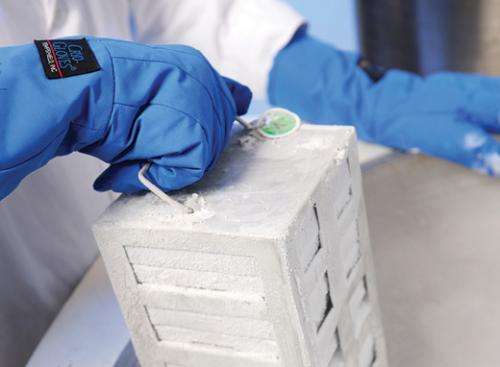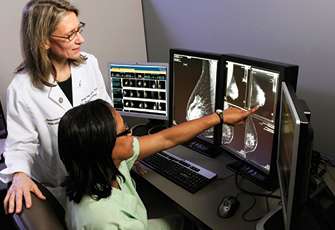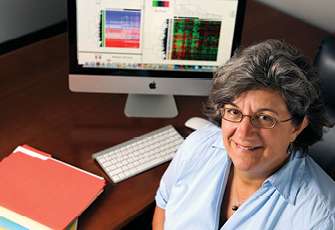Finding breast cancer answers in the freezer

Patients who have a biopsy or surgery connected to a breast cancer diagnosis at Winship Cancer Institute are often asked to allow some of their left-over tissue to be used in Emory's breast tissue bank. Patients who consent are helping researchers at Emory and all across the country find answers to improving diagnosis, treatment, even prevention of breast cancer.
Winship set out to build a more comprehensive breast tissue bank in 2010. Today, Emory's breast tissue procurement and banking program, designed by three of Winship's leading breast cancer researchers and funded by the Wilbur and Hilda Glenn Family Foundation, has greatly expanded and is enabling researchers to more easily and more quickly find the breast tissue they need to move forward.
Expanding breast tissue collection and storage
Collecting and banking tissue of patients is not new. For years, surgical oncologists have taken tissue specimens during biopsies or operations to remove a tumor, tissue samples that allow them to make a diagnosis and, if found to be cancerous, to determine tumor type, size, and characteristics. They also use tissue specimens to make sure the margins (edges) of the excision are clean, meaning no cancer cells have been left behind. Part of the tissue sample is then stored, available if later needed by the clinician, perhaps to compare to a second tumor.
Diagnosis and treatment of the individual patient always will be the primary use for tissue samples, but researchers know the tissues also hold answers for all breast cancer patients. In the past, only a small percentage of tissues was available for research. Now, nearly all breast cancer patients seen at Emory are being asked if they will consent to having tissue left over from their clinical procedures be made available for use by breast cancer researchers.

"Almost all of them agree," says Sheryl Gabram-Mendola, expert in the surgical treatment of breast cancer for Winship and Grady Memorial Hospital. "There is no downside, and most women are eager to help other women who have or may develop breast cancer."
Working with Gabram-Mendola to grow the program are Paula Vertino, head of Winship's Cancer Genetics and Epigenetics program, and Ruth O'Regan, director of translational breast cancer research and a physician with a major interest in triple negative breast cancer. It's a good team. Gabram-Mendola helped build a system for consistently collecting tissue samples and data across three clinical sites. Vertino and her team of genetic researchers make sure other scientists know the tissue is available and they facilitate its appropriate use. O'Regan oversees the design of clinical studies using the data. The recent establishment of the Glenn Family Breast Center at Winship helped further boost the breast tissue bank program and a range of related research projects.
The tissue bank collection/consent mechanism is now in place at Emory University Hospital, Emory University Hospital Midtown, and the Avon Breast Center at Grady Memorial Hospital. Research coordinators approach over 90 percent of Winship breast patients to get permission to use their tissue samples in studies, now or in the future.
It works this way. When a patient is having a procedure, a research project coordinator at the site explains to her how researchers use the left-over tissue and asks if she would be willing to sign a consent form allowing her tissue to be available to them. If she says yes, the clinician places the extra cells in a glass tube and hands them to the coordinator, who is waiting outside the procedure or operating room. The coordinator then processes and freezes the cells. Thanks to a sophisticated data management system created for the tissue bank, patients are identified only by numbers to protect their confidentiality, but each tissue sample is linked to a large database of information about the patient, such as age, weight, medical history, and behaviors like smoking, alcohol use, and exercise.

This is a model also used at other National Cancer Institute-designated cancer centers, part of a movement toward precision medicine: being able to combine hundreds, even thousands of bits of cellular, clinical, genetic, environmental, behavioral and other information to allow researchers and clinicians to better understand an individual's cancer and identify the exact "personalized" medical treatment that will work best for that individual.
Winship is at the cutting edge of this trend, says Gabram-Mendola. In addition to collecting cells from an initial breast cancer, as is common, it also collects and stores normal cells (40 percent of breast biopsies turn out to be negative for breast cancer) and – even more visionary – metastatic cells: breast cancer cells that have spread to other organs, such as the lungs, bones, or liver.
What also makes Winship's tissue bank especially valuable is its size and make-up. More than 1,000 breast cancer patients are seen per year at the three sites, and, given Atlanta's demographics, especially at Grady, a higher than average proportion of patients are minorities – African Americans, Latinas, Asians, and others who too often have not been well represented in research studies.
"We already had some of the pieces of a good tissue bank program," says Gabram-Mendola, "but we needed a system-wide patient database and a robust information technology system to connect pathology and clinical data. The gift from the Glenn family, long-time supporters of Winship, allowed us to build that. Having the breast cancer tissue bank and database makes our researchers more competitive for NCI and other research funding and better able to tackle the complexities of breast cancer."















